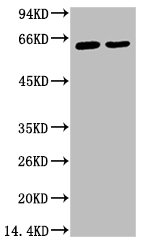Cytokeratin 6 antibody
GTX105355
ApplicationsWestern Blot, ImmunoHistoChemistry, ImmunoHistoChemistry Paraffin
Product group Antibodies
TargetKRT6A
Overview
- SupplierGeneTex
- Product NameCytokeratin 6 antibody
- Delivery Days Customer9
- Application Supplier NoteWB: 1:500-1:3000. IHC-P: 1:100-1:1000. *Optimal dilutions/concentrations should be determined by the researcher.Not tested in other applications.
- ApplicationsWestern Blot, ImmunoHistoChemistry, ImmunoHistoChemistry Paraffin
- CertificationResearch Use Only
- ClonalityPolyclonal
- Concentration0.34 mg/ml
- ConjugateUnconjugated
- Gene ID3853
- Target nameKRT6A
- Target descriptionkeratin 6A
- Target synonymsCK-6C, CK-6E, CK6A, CK6C, CK6D, K6A, K6C, K6D, KRT6C, KRT6D, PC3, keratin, type II cytoskeletal 6A, cytokeratin 6A, cytokeratin 6C, cytokeratin 6D, keratin 6A, , type II, keratin 6A, type II, keratin, epidermal type II, K6A, type-II keratin Kb6
- HostRabbit
- IsotypeIgG
- Scientific DescriptionThe protein encoded by this gene is a member of the keratin gene family. The type II cytokeratins consist of basic or neutral proteins which are arranged in pairs of heterotypic keratin chains coexpressed during differentiation of simple and stratified epithelial tissues. As many as six of this type II cytokeratin (KRT6) have been identified; the multiplicity of the genes is attributed to successive gene duplication events. The genes are expressed with family members KRT16 and/or KRT17 in the filiform papillae of the tongue, the stratified epithelial lining of oral mucosa and esophagus, the outer root sheath of hair follicles, and the glandular epithelia. This KRT6 gene in particular encodes the most abundant isoform. Mutations in these genes have been associated with pachyonychia congenita. The type II cytokeratins are clustered in a region of chromosome 12q12-q13. [provided by RefSeq]
- Storage Instruction-20°C or -80°C,2°C to 8°C
- UNSPSC12352203
References
- Examination of endothelial cell-induced epidermal regeneration in a mice-based chimney wound model. Seo J et al., 2016 Jul, Wound Repair RegenRead more
- Downregulation of TNIP1 Expression Leads to Increased Proliferation of Human Keratinocytes and Severer Psoriasis-Like Conditions in an Imiquimod-Induced Mouse Model of Dermatitis. Chen Y et al., 2015, PLoS OneRead more


![FACS analysis of HeLa cells using GTX17910 Cytokeratin 6A antibody [KRT6A/2368]. Blue : Primary antibody Red : Isotype control](https://www.genetex.com/upload/website/prouct_img/normal/GTX17910/GTX17910_20200115_FACS_191_w_23060620_116.webp)


